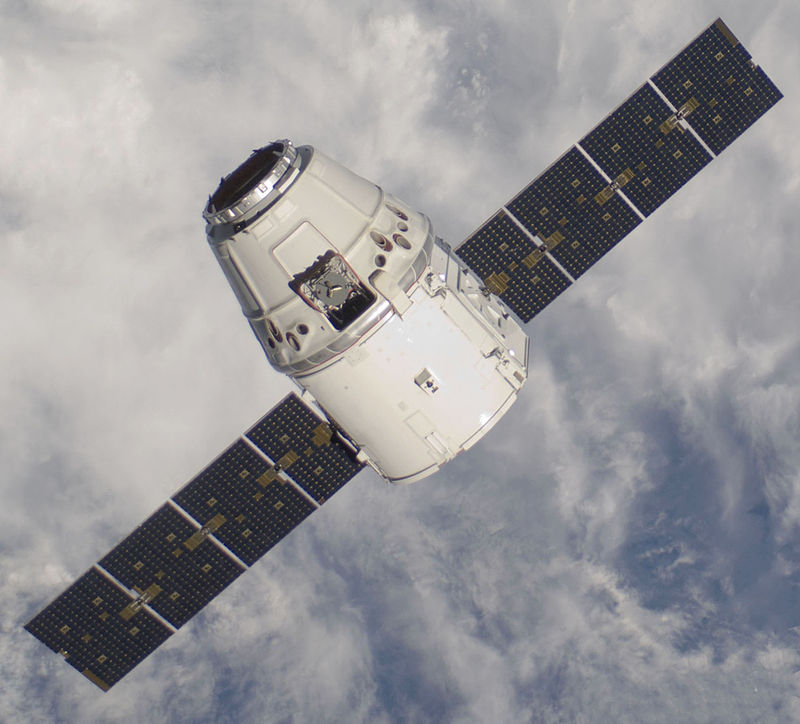Dragon.6.jpg

Potential contamination carried by space vehicles is a major concern to the public and private space industry. Satellites and space craft components are manufactured in clear rooms to prevent the possibility of biological contamination of astronomical bodies. However, recently a new type of contamination was discovered. SpaceX cargo flights to the International Space Station (ISS) are apparently contaminating the outside of Station with gases carried from Earth to orbit.
In early 2017, a SpaceX Falcon 9 rocket carried a Dragon capsule to rendezvous with the ISS. One of the pieces of equipment in the supply capsule was the SAGE III. This device was designed to measure ozone molecules and aerosols in the atmosphere of the Earth. SAGEs I and II had already documented the growth of holes in the Earths ozone layer and the shrinking of the holes after the elimination of the use of Freon.
SAGE III is extremely sensitive. One of the concerns with such sensitivity is that environmental contamination could affect its readings. To combat this, the device contains contamination sensors. Following the delivery of the SAGE III to the ISS and its installation, the subsequent arrivals of Dragon supply capsules triggered these contamination sensors. These Dragon capsules were outgassing something that was affecting the function of the SAGE III.
New pieces of equipment can outgas molecules that have migrated from the interior of the equipment to their surfaces. This can result in a greasy film forming in the neighborhood of the equipment. In the case of the ISS, molecules delivered by the Dragon capsules were adhering to the SAGE III.
This same problem was discovered when components of the Hubble Space Telescope were returned to Earth. The contamination outgassed from the body of the Hubble degraded the ability of the instruments to detect ultraviolet light which was critical to the Hubble mission.
While NASA has dealt with such contamination for decades, the situation with the Dragon capsules is new. NASA is outsourcing more and more work to private space companies. It is critical for the success of such joint ventures to work that NASA be able to depend on private space contractors to deal properly with their own sources of contamination.
Contamination detection on the SAGE III is carried out by eight “thermoelectric quartz crystal microbalances” that each contain two crystals. Each crystal oscillates at a frequency that is related to the mass of the sensor. If any of the crystals gain mass from such sources as the Dragon capsules, its frequency is altered.
When the SAGE III arrived at the ISS, each pair of crystals in the microbalances oscillated at exactly the same frequency. One of the two crystals is exposed to space and the other is protected by a container. If the exposed crystal gains mass, this changes its frequency, so the two crystals are no longer in synchronization. This results in a signal being generated that there is contamination in the environment. There are other highly sensitive sensors on the SAGE III that could be affected by contamination. Subsequent arrivals of Dragon capsules caused the microbalances to register up to seventy times the allowed level of contaminants.
At first it was suspected that solar panels on the Dragon capsules were outgassing but this was tested and eliminated as a contamination source. Now it is suspected that the body of the Dragon capsule is the source. Altogether, seven sensitive areas or instruments on the ISS may be in dangers from the contamination.
NASA and SpaceX are working on identifying the source of the outgassing from the Dragon capsules. One independent analyst believes that the source of the outgassing is the paint on the outside of the Dragon capsules. One family of paints used on spacecraft such as the Dragon capsules is known to breakdown and outgas if it is contaminated and then exposed to ultraviolet light which is plentily in space.
NASA is reluctant to share information on the problem and actions taken to prevent such outgassing in the future. Reporters questions have been gone unanswered and documents about the problem have been removed from public access. It would be better for all involved if NASA was more open about this problem.